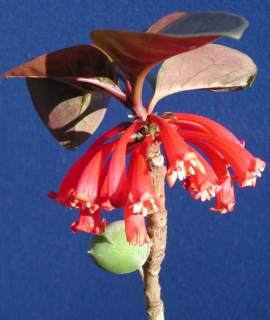Dermatobotrys saundersii
Dermatobotrys saundersii Bolus ex Oliv.
Family: Scrophulariaceae
Common names: tree jockey
Introduction
Dermatobotrys saundersii is unusual in that it is an epiphytic shrublet, which grows in the forks of a variety of trees, and occasionally on the forest floor.

Description
Description
It can reach one metre in height. The leaves are soft and fleshy with shallow toothed margins and reddish veins. Under natural conditions the plant is deciduous, losing its leaves in late autumn. The tubular deep red flowers appear from mid-winter to mid-summer (June to December), followed by smooth oval brownish fruit filled with numerous small seeds in a sweetish pulp.
Conservation Status
Status
Although it is regarded as not threatened, and assessed as Least Concern (LC) on the Red List of South African plants, this is a rare species with a high habitat specificity.
Distribution and habitat
Distribution description
This plant is found in coastal scarp forests from southern Zululand to the Transkei and in Madagascar.
Derivation of name and historical aspects
History
The name Dermatobotrysis derived from the Latin derma meaning 'skin', and botrys meaning 'bunch of grapes'. Although the plant was first collected by W.T.Gerrard in the mid-19th century, the specific name comes from Sir Charles James Renault Saunders who collected the plant in Zululand, as Harry Bolus, who described the plant, was apparently unaware of the earlier collections.
The genus Dermatobotrys has only one species. Seeds sent to Kew in the 1890s germinated well and plants have been grown in cultivation ever since.
Ecology
Ecology
It is likely that this plant with its red tubular flowers is pollinated by sunbirds. The fruit has a most unusual scent, which may attract fruit eating birds and small arboreal mammals, which eat the fruit and distribute the seed.
Growing Dermatobotrys saundersii
Grow
These attractive plants are easily grown from seed or cuttings and make very good container plant subjects. They should be grown in well-drained humus rich soil and in partial shade. It is important to not over-water. The plant will thrive in the same container for several years if fed monthly during the growing season.
This unusual plant is well worth growing as a container plant, or planted in the forks of tall trees where humus has collected.
References
- Beckett, K. 1993. Trumpets in winter. The Garden. RHS.118(10): 474-475
- Pooley, E. 1998. A field guide to the wildflowers of Kwazulu-Natal and the eastern region. Natal Flora Trust.
- Scott-Shaw, R. 1999. Rare and threatened plants of KwaZulu-Natal and neighbouring regions. KwaZulu Natal Conservation Service.
Credits
Isabel Johnson
KwaZulu-Natal National Botanical Garden
September 2002
Plant Attributes:
Plant Type: Epiphyte
SA Distribution: Eastern Cape, KwaZulu-Natal
Soil type:
Flowering season: Spring, Early Summer, Winter
PH: Neutral
Flower colour: Red
Aspect: Full Sun, Shade, Morning Sun (Semi Shade)
Gardening skill: Average
Special Features:
Horticultural zones








Rate this article
Article well written and informative
Rate this plant
Is this an interesting plant?
Login to add your Comment
Back to topNot registered yet? Click here to register.